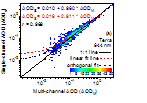STAR / SMCD / EMB Aerosol Remote Sensing
Analysis of Aerosol Data
This
research is intended to develop a global long-term satellite
climatology of aerosol properties based on a consistent combination
of previous, current and future satellite retrievals. Consistent with
this objective, we quantify the accuracy and limits of applicability
of the NESDIS AVHRR-based aerosol dataset; quantify the extent to which
it is coherent, complimentary, and/or contradictory to other selected
satellite-derived aerosol datasets (e.g., MODIS). An important element
of this work is a retrospective analysis
of the AVHRR dataset in order to infer the three-decade-long
pattern of the global distribution of aerosols, their properties, and
seasonal, interannual, and decadal variations.
The research also supports NOAA's Climate Goal, which has a requirement for the observation of aerosol properties. The Climate Goal is broadly matrixed across NOAA with large research contributions from NOAA's Office of Oceanic and Atmospheric Research (OAR), as well as contributions from several operational NOAA organizations including NESDIS, and the Climate Prediction Center (CPC), which is within the National Weather Service (NWS). (Read more ...)
Single- and multi-channel algorithms
 Past comparisons of the
various satellite climatologies of aerosol revealed their differences,
and concluded that many were due to uncertainties in input radiances
that are the results of differences in instrument calibration and in
cloud detection, and cannot be explained by algorithm differences only.
For example, it was shown that when single- and multichannel
algorithms are applied to the exact same radiances the aerosol optical
thickness differences are significantly reduced. This conclusion
also seems to support the possibility of extending the more recent multi-channel
MODIS
record back in time with the AVHRR data, and thereby creating a
long-term, consistent, and calibrated data record. (Read
more ...)
Past comparisons of the
various satellite climatologies of aerosol revealed their differences,
and concluded that many were due to uncertainties in input radiances
that are the results of differences in instrument calibration and in
cloud detection, and cannot be explained by algorithm differences only.
For example, it was shown that when single- and multichannel
algorithms are applied to the exact same radiances the aerosol optical
thickness differences are significantly reduced. This conclusion
also seems to support the possibility of extending the more recent multi-channel
MODIS
record back in time with the AVHRR data, and thereby creating a
long-term, consistent, and calibrated data record. (Read
more ...)
